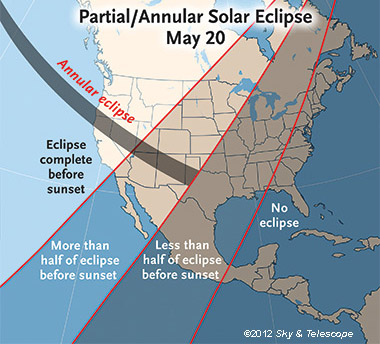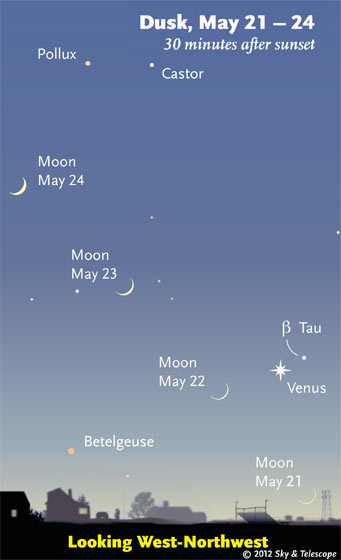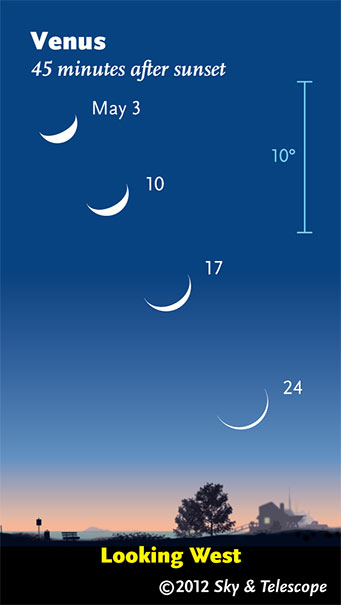Friday, May 18
Saturday, May 19

Nearly all North America gets at least a partial eclipse on May 20th, with the Moon taking a big bite out of the Sun. The eclipse will still be in progress at sunset for much of the U.S., Canada, and Mexico. Article.
Sunday, May 20
See our article, May 20th's Annular Eclipse of the Sun, which has links to more detailed maps, local timetables, and many other resources, including How to Watch Safely. Warning: Looking at any part of the bright Sun without a proper, safe solar filter can permanently damage your vision.

Day by day the waxing Moon marches up away from the Sun, even as Venus moves (more slowly) down toward the Sun. Visibility of the faint objects in bright twilight is exaggerated; bring binoculars. As always, the scene is exact for the middle of North America: at latitude 40° N, longitude 90° W. The Moon is shown three times its actual apparent size.
Sky & Telescope diagram
Monday, May 21
Tuesday, May 22
Wednesday, May 23
Thursday, May 24
Friday, May 25
Saturday, May 26
Want to become a better amateur astronomer? Learn your way around the constellations. They're the key to locating everything fainter and deeper to hunt with binoculars or a telescope.
For an easy-to-use constellation guide covering the whole evening sky, use the big monthly map in the center of each issue of Sky & Telescope, the essential magazine of astronomy. Or download our free Getting Started in Astronomy booklet (which only has bimonthly maps).
Sky Atlas 2000.0 (the color Deluxe Edition is shown here) plots 81,312 stars to magnitude 8.5. That includes most of the stars that you can see in a good finderscope, and typically one or two stars that will fall within a 50× telescope's field of view wherever you point. About 2,700 deep-sky objects to hunt are plotted among the stars.
Alan MacRobert
Once you get a telescope, to put it to good use you'll need a detailed, large-scale sky atlas (set of charts). The standards are the little Pocket Sky Atlas, which shows stars to magnitude 7.6; the larger and deeper Sky Atlas 2000.0 (stars to magnitude 8.5); and the even larger Uranometria 2000.0 (stars to magnitude 9.75). And read how to use sky charts effectively.
You'll also want a good deep-sky guidebook, such as Sue French's Deep-Sky Wonders collection (which includes its own charts), Sky Atlas 2000.0 Companion by Strong and Sinnott, the bigger Night Sky Observer's Guide by Kepple and Sanner, or the classic if dated Burnham's Celestial Handbook.
Can a computerized telescope replace charts? I don't think so — not for beginners, anyway, and especially not on mounts and tripods that are less than top-quality mechanically (able to point with better than 0.2° repeatability). As Terence Dickinson and Alan Dyer say in their invaluable Backyard Astronomer's Guide, "A full appreciation of the universe cannot come without developing the skills to find things in the sky and understanding how the sky works. This knowledge comes only by spending time under the stars with star maps in hand."
This Week's Planet Roundup

Seen in a telescope, Venus in the western dusk is enlarging in diameter while waning in phase. It's moving down Sunward, swinging (in its faster orbit) toward the line between Earth and Sun. The 10° scale refers to Venus's height above the horizon 45 minutes after sunset.
Sky & Telescope diagram
Mercury is buried in the glare of the Sun.
Venus (magnitude –4.5, in Taurus) is the bright "Evening Star" in the west-northwest in twilight. It's dropping lower every day; see article Venus Takes the Plunge.
Look for Capella 20° to Venus's upper right (not shown here). Look just 2° or 3° to Venus's right or upper right for fainter Beta Tauri.
In a telescope, Venus is a dramatic, thin crescent becoming more interesting all the time. This week it enlarges from 50 to 54 arcseconds tall while waning from 10% to just 4% sunlit. You may even see the crescent with firmly braced binoculars.
Venus is plunging toward inferior conjunction, when it will transit the face of the Sun on June 5–6 (on the afternoon of the 5th for North America); for details see our article Transit of Venus. This will be the last Venus transit until 2117.
Mars (magnitude +0.3) shines orange under the belly of Leo. It's high in the south-southwest at dusk and lower in the southwest to west later in the evening. Spot Regulus 10° or 12° to Mars's right in twilight, and to its lower right later. They're moving farther apart daily. Fainter Gamma Leonis is 8° above Regulus; the three form a triangle. Mars in a telescope is gibbous and very small (about 8.5 arcseconds wide), fading and shrinking.
Jupiter is buried deep in the glow of sunrise.
Saturn (magnitude +0.3, in Virgo) shines high in the south after dark. Spica, fainter and bluer, is nearly 5° to Saturn's lower right early in the evening, and directly below it later.
Uranus (magnitude 5.9, at the Pisces-Cetus border) is very low in early dawn.
Neptune (magnitude 7.9, in Aquarius) is low in the east-southeast before dawn's first light.
All descriptions that relate to your horizon — including the words up, down, right, and left — are written for the world's mid-northern latitudes. Descriptions that also depend on longitude (mainly Moon positions) are for North America. Eastern Daylight Time (EDT) equals Universal Time (also known as UT, UTC, or GMT) minus 4 hours.
Like This Week's Sky at a Glance? Watch our weekly SkyWeek TV short. It's also playing on PBS!
To be sure to get the current Sky at a Glance, bookmark this URL:
http://SkyandTelescope.com/observing/ataglance?1=1
If pictures fail to load, refresh the page. If they still fail to load, change the 1 at the end of the URL to any other character and try again.
 0
0
Comments
You must be logged in to post a comment.